
Pyrite Gemstone: Meanings, Healing Properties, Uses & More!
 Pyrite gemstones are a pale brassy-yellow iron sulfide gemstone with a metallic luster. The color and luster resemble gold, earning it the nickname “fool’s gold.”
Pyrite gemstones are a pale brassy-yellow iron sulfide gemstone with a metallic luster. The color and luster resemble gold, earning it the nickname “fool’s gold.”
Is pyrite a precious stone? No, pyrite is a semi-precious gemstone. Well, is pyrite a rare mineral? Nope, pyrite is abundant! In fact, the stone is the most common sulfide worldwide.
If it’s not rare, gold, or a precious gem, what is so special about pyrite? Plenty! Despite the “fool’s gold” moniker, pyrite offers plenty of value as a spiritual, industrial, and jewelry material!
Today, you’ll learn everything that makes this gem so powerful, from pyrite’s crystal meaning and uses, to its properties and price!
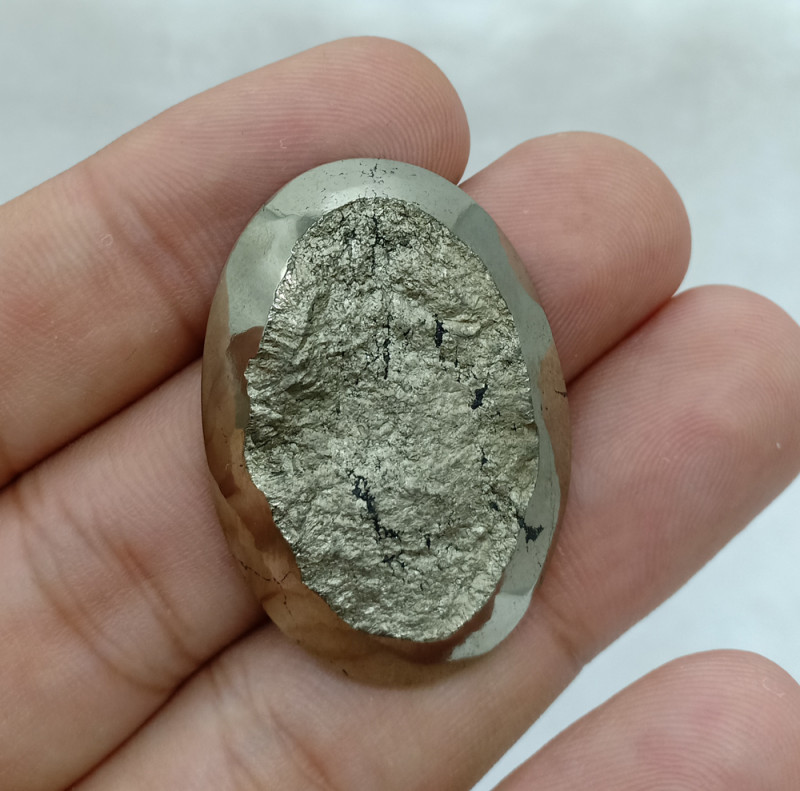
About Pyrite Stone
Pyrite may be called iron pyrite or simply iron disulfide. The stone’s metallic color can range from pale brass to more saturated gold hues. One pyrite variety can shimmer in every color: rainbow pyrite!
Rainbow pyrite, or iridescent pyrite, is a type of pyrite druzy. “Druzy” refers to gemstones coating a stone in tiny, glittering crystal clusters or crusts.
Pyrite isn’t a birthstone, but it is an astrological stone! The golden gem is a zodiac stone for Leo, as well as a star stone for the sun and Mercury.
Pyrite Specifications & Characteristics
Pyrite belongs to the pyrite mineral group, though it also falls under the sulfide classification. The only mineral in line with pyrite’s properties is marcasite, a pale silvery-yellow stone with green undertones. Marcasite has the same chemical composition as pyrite but a different crystal structure.
What minerals are found in pyrite? Well, pyrite is usually found in other minerals like Colombian emerald, lapis lazuli, and Ceylon sapphire, just to name a few. As far as elements, though, pyrite may contain nickel, cobalt, copper, lead, arsenic, and even gold!
With so many metals inside, is pyrite magnetic? Not exactly. Pyrite is paramagnetic, meaning it shows temporary, weak magnetism around an applied magnetic field. A similar-looking mineral, pyrrhotite, is often called “magnetic pyrite,” though its magnetism is weak.
Find the rest of pyrite’s mineral data below!
Color: Brass yellow to dull brass or silver; Sometimes has iridescent tarnish
Mohs Hardness: 6-6.5
Crystal structure: Isometric
Luster: Metallic
Transparency: Opaque
Refractive index: 1.73-1.83
Density: 4.8-5.2
Cleavage: Poor/Indistinct on [001] and [110]
Fracture: Irregular/Uneven, sometimes conchoidal
Streak: Greenish-black to brownish-black
Before we get into pyrite’s spiritual properties, let’s discuss what sets “fool’s gold” apart from real gold.

Pyrite vs. Gold
First, it’s important to note that pyrite may contain gold. Called auriferous pyrite, these specimens can have 0.25+ percent gold by weight.
Pyrite and gold have similar coloring and luster, along with similar formation. The main distinguishing features between them are texture, color, hardness, and density.
Texture: Raw pyrite stone has sharp crystals, while raw gold’s edges are smoother and rounder.
Color: Real gold’s color is bright, yellow-gold, while pyrite is more brassy in tone, sometimes with silver undertones.
Streak: The pyrite streak is greenish- or brownish-black but gold has a golden-yellow streak.
Hardness: Pyrite’s hardness (6-6.5) is much harder than gold’s hardness (2.5). Even a fingernail can scratch gold.
Density: Pyrite feels much lighter than gold. Pyrite’s density is 4.8-5, while gold’s density is 1.5 times higher!
Another identification method is melting. Real gold will melt, but pyrite won’t melt, only decompose. Plus, pure pyrite can be used for jewelry, while pure gold has to be mixed with other metals to create wearable pieces.
Now that you have a good grasp on the mineral side, what is the meaning of pyrite gemstone?
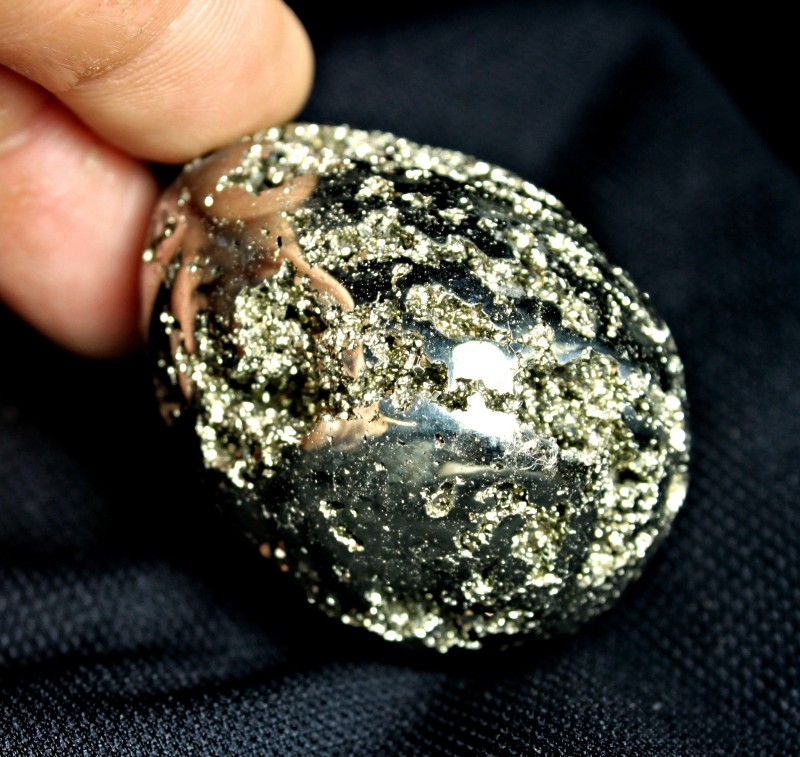
Pyrite Meaning & History
Pyrite has been significant since prehistoric times! Archeological evidence of pyrite at prehistoric burial mounds has led scientists to theorize even cavemen used the stone.
Ancient Incas viewed pyrite gemstone’s meaning as a tool for magic and meditation, while Native Americans used polished ones as mirrors. Elsewhere, like ancient Sumerian texts and Medieval poetry, the stone represented things that were “overvalued.”
If it was a symbol of the overrated, does pyrite bring good luck still? Absolutely! In fact, some nicknames for pyrite include “Stone of Wealth” and “Stone of Luck.”
Symbolically, pyrite stone’s spiritual meaning is one of mental fortitude, abundance, and imagination.
Pyrite History
Pyrite’s name comes from the Greek pyrites lithos, meaning “stone which strikes fire.” Ancient peoples would strike pyrite with another mineral like flint, creating sparks for starting fire.
Where did the nickname “fool’s gold” come from? The most famous instance was the 1849 “Gold Rush,” when swarms of Americans migrated to California to find gold. Miners commonly mistook pyrite for gold during this era, but this “foolish” mistake goes even further back.
English privateer Martin Frobisher got royal funding in 1577 to bring back a “sparkly black rock” from Canada. He shipped some 1,600 tonnes back, only for it to be ordinary rock with pyrite sparkles.
In 1608, John Smith — yep, the Pocahontas one — bought some 1,100 tonnes of sand from local Native American tribes on orders from his captain, Christopher Newport. Newport was convinced the sand had gold, bringing it back to England only to realize it was pyrite sediment.
Despite the many disappointing instances, pyrite was crucial throughout human history. It ignited gunpowder in wheel-lock guns, provided sulfur and iron, and started fires.
In jewelry, pyrite became popular during the mid-19th century in the US and Europe, though it was often mislabeled as marcasite.
We know the historical uses, but today, what is the crystal pyrite good for?
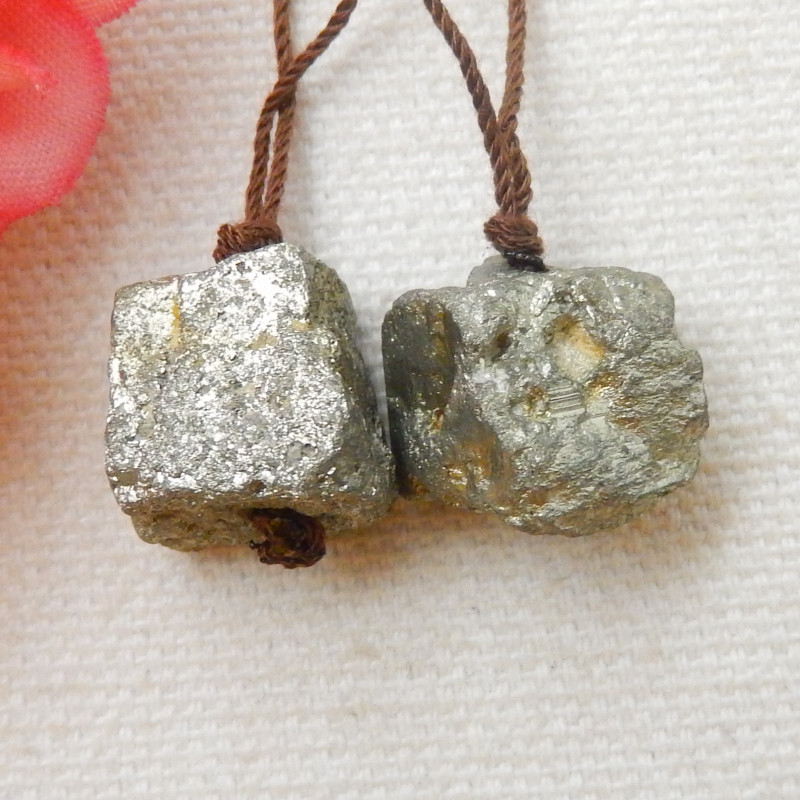
Pyrite Healing Properties
Gemstones’ colors and energies make them useful as healing stones. Gold is the color of warmth, wealth, and prestige, and like other yellow and gold gemstones, pyrite can enhance joy and focus.
For specific healing, what is pyrite used for?
Physical Healing
Crystal healers use pyrite for protection from environmental pollutants (like computer EMF emissions) and for treating lung issues
Other purported physical pyrite gemstone benefits include strengthening bones, memory, and cell formation.
Emotional Healing
If negativity seems to always find you, pyrite can provide protection from negative energies, along with clarifying the truth so you can kiss those anxious thoughts goodbye.
Pyrite crystal is also nicknamed the “Stone of Prosperity” for its alleged abilities to attract abundance and increase self-confidence.
Spiritual Healing
Pyrite is a powerful crystal in Feng Shui. Practitioners recommend pyrite for bettering your finances and balancing masculine and feminine strengths.
Where do I place pyrite stone? The best Feng Shui areas for pyrite are:
Xun Area: Place in the far-left corner of a room to attract wealth and abundance,
Qian Area: Place in the right-hand corner closest to you in the room to attract benevolent people into your life.
Now, what chakra is pyrite good for?
Chakra healing involves balancing your chakras (seven energy centers) to address symptoms of a blockage. Pyrite crystal chakra healing is best for the solar plexus chakra.
You’ll know your solar plexus chakra is blocked if you feel insecure or detached from the world and yourself. Using pyrite as a chakra stone, you can invite in all the feelings of an open solar plexus: motivation, purpose, and confidence.
If you want confidence in your purchase, learn which value factors to look for below!

Pyrite Gemstone Properties
Gemstone properties, or value factors, help experts determine a gemstone’s objective value. Pyrite’s value is determined by its color and cut.
Color
Pyrite’s color can range, but richer gold hues are more valuable. Rainbow pyrite shows numerous colors in its iridescence, but the highest-valued specimens show every color in the rainbow.
Cut
Cut pyrite, faceted or not, is usually more valuable than a raw pyrite stone because the stone’s brittle nature and heat sensitivity requires expertise.
Common faceted cuts for pyrite include round, pear, and checkerboard. Jewelers may use these faceted stones on their own, in a pyrite stone necklace for example, or combine them with unfaceted cuts to create faceted beads or faceted cabochons.
Another common method is the rose cut, where the stone’s base is flat and unfaceted, but the top has a dome shape with triangular facets. Popular unfaceted cuts for pyrite include cabochons, carvings, and beads.
Rough pyrite has some value, as the stone can form into many beautiful shapes. For instance, a Spanish pyrite cube forming a matrix with its host rock is sought-after by collectors. Another raw type is cathedral pyrite, where the stone has gothic-like markings etched into it.
Clarity
Pyrite is an opaque stone that is often an inclusion in other stones, including:
Aventurine
Bloodstone
Beryl (Emerald, Aquamarine)
Chrysoberyl
Feldspar (Sunstone, Oligoclase, Labradorite)
Garnet (Hessonite)
Lapis Lazuli
Sapphire
Sodalite
Sphalerite
Tourmaline (Dravite)
Turquoise
Before it even gets to a jeweler, pyrite has to form first, so, how does it form and where is pyrite found?

Pyrite Origins & Sources
Pyrite forms in various shapes, rocks, and conditions. Some common environments include hydrothermal veins, sedimentary deposits, segregated magma concentrations, and metamorphic rocks.
In sedimentary deposits, pyrite forms where there isn’t much oxygen, but there is iron and sulfur. Often, these environments (like coal and dark shale) contain organic material decaying, taking oxygen, and releasing sulfur.
Pyrite shapes include cubes, pyritohedron, and penetration twinning (multiple intergrown crystals). Pyrite (or marcasite) crystals that form a flat disc of radiating crystals are called a “pyrite dollar” or “pyrite sun.”
Now, where is the mineral pyrite found?
Mining Locations
Rainbow pyrite only comes from Russia, but there are thousands of pyrite locations worldwide. Some prominent sources are well-known for their particular pyrite, like:
Italy: High-quality pyritohedral pyrite
Peru: Huge deposits of pyrite crystal clusters
Spain: Famous for having perfect, large crystals and perfect pyrite cubes often embedded in a tan matrix
Tanzania: Recently discovered deposit with complex, uniquely shaped crystals
USA: Large pyritohedrons and cubes from Utah; Large intergrown cubes from Colorado; Pyrite dollars (suns) from Illinois; Octahedral crystals from Pennsylvania; Huge rounded, tubular pyrite growths from Ohio
Next, let’s cover what to expect for pyrite’s price.
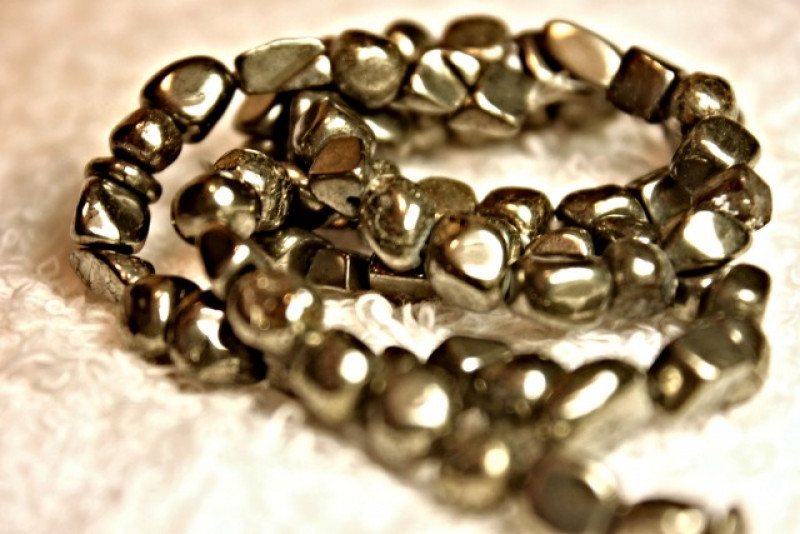
Pyrite Gemstone Price & Value
Luckily, pyrite is affordable! The priciest pyrite is a faceted pyrite gemstone, typically $5-$8 per carat. Next are pyrite cabochons, at around $1 per carat.
Rough (raw) pyrite costs between $0.03-$0.05 per carat, while sample specimens are $0.30-$0.65 per carat. If you’re looking for “fool’s gold” nuggets, you can find 1-lb bags for $10.
If you find real gold in a pyrite stone for sale, it will command much higher prices. Gold-bearing pyrites usually have around 0.25 percent gold by weight, so let’s say gold currently costs $1,500 per troy ounce (1 troy oz = 31.1 g). One ton of that gold-bearing pyrite will have roughly 73 troy ounces of gold, worth over $100,000!
However, if you’re planning on selling the gold inside a pyrite, the value also depends on how well the gold can be taken out and how costly that process is.
Regardless of price, the value pyrite brings goes beyond money. Part of its value is how well you care for your pyrite!
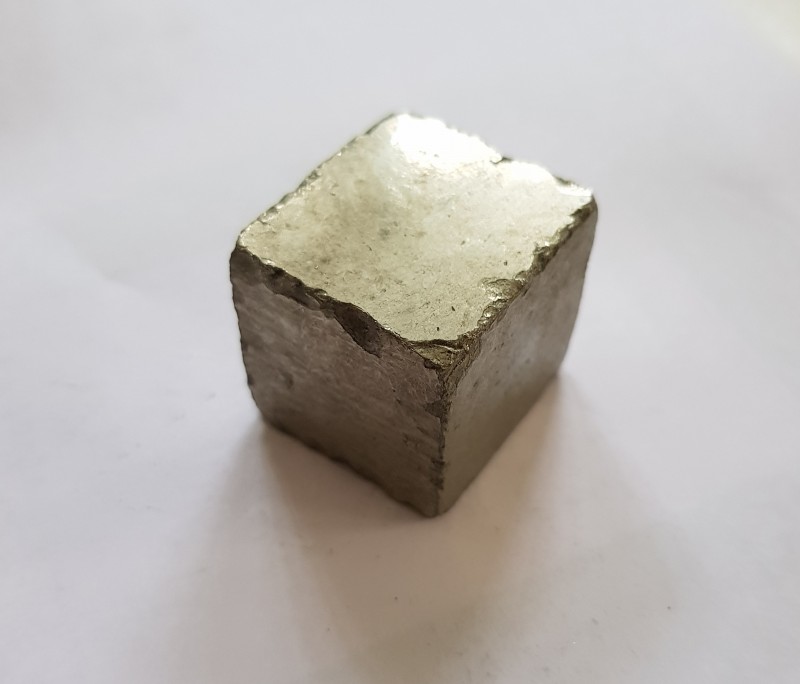
Pyrite Care and Maintenance
For regular cleanings, wash the stone in lukewarm, soapy water, then rinse it. To prevent oxidation, thoroughly dry the stone and its jewelry setting with a soft cloth.
To clean tarnish from pyrite, you can use a rust stain solution or soak the stone in a 2:1 solution of distilled water and vinegar for 5 minutes. After either method, rinse the stone with clean water and thoroughly dry it.
The best storage for pyrite is in a dry environment, like a sealed plastic container, away from other gemstones and carbonate minerals like calcite (whose acid fumes could damage your pyrite).
Strike Gold with Pyrite!
They say all that glitters is not gold, but pyrite is still a glimmering treasure!
It may be known as “fool’s gold,” but pyrite’s benefits are no joke. With affordable prices, unique shapes, and the ability to attract wealth, what’s not to love about pyrite?
Want to look and feel like a million bucks? Shop for pyrite gemstones today!
Search the Gemstone Encyclopedia
Related Auctions
Related Articles
Originally the Birthstones or gemstones were associated with a zodiac sign or the month of a individuals birth. Find out what your stone is and view the stones we have for sale
8th Feb 2021
There are dozens of quartz and chalcedony gems with various colors and patterns. Learn all about quartz properties and every type of quartz, from amethyst and agate to plasma and phantom quartz!
15th Oct 2020
Hackmanite is a pink to violet sodalite gem known for its unique color-change and luminescence. Learn why hackmanite is special, from its rare qualities to the types of hackmanite jewelry available.
28th Mar 2018
Latest Articles
Yugawaralite is a rare colorless, white, or pinkish zeolite crystal named for its discovery in Yugawara, Japan. Here we uncover the multifaceted history, properties, prices, and uses of yugawaralite.
24th Mar 2025
Simpsonite is a lesser-known mineral known on the gem market for its durability, yellow-orange color, and rarity. Discover all the properties, uses, prices, and history of simpsonite.
3rd Mar 2025
Kurnakovite is a colorless crystal related to inderite and rarely faceted but known among collectors. Explore the mineral traits, history, prices, and more in this kurnakovite guide.
17th Feb 2025
Article Categories
How To's is where you will find helpful articles from gem Rock Auctions on how to cut gemstones, select gemstones and buy gemstones.
9 Articles





